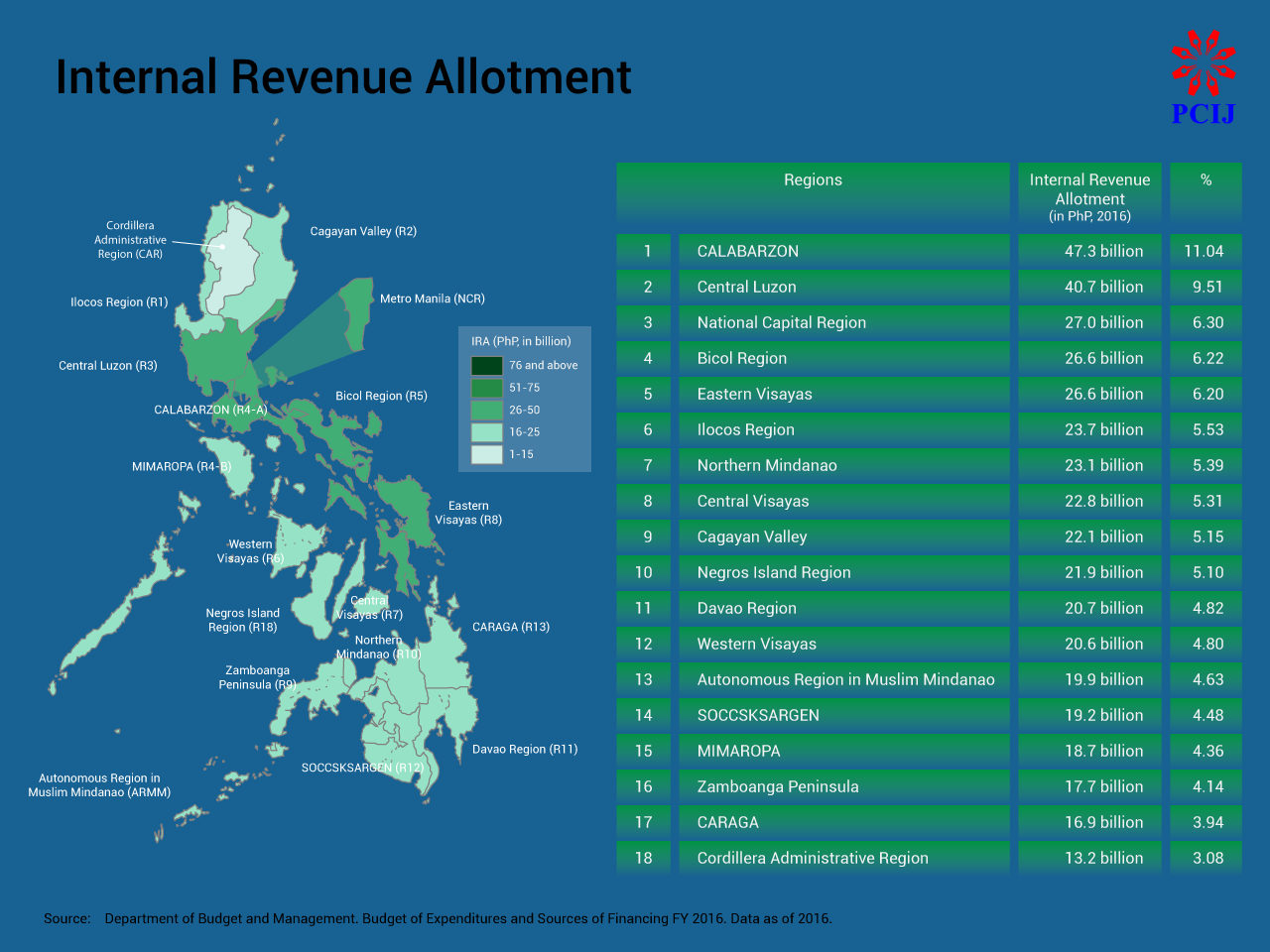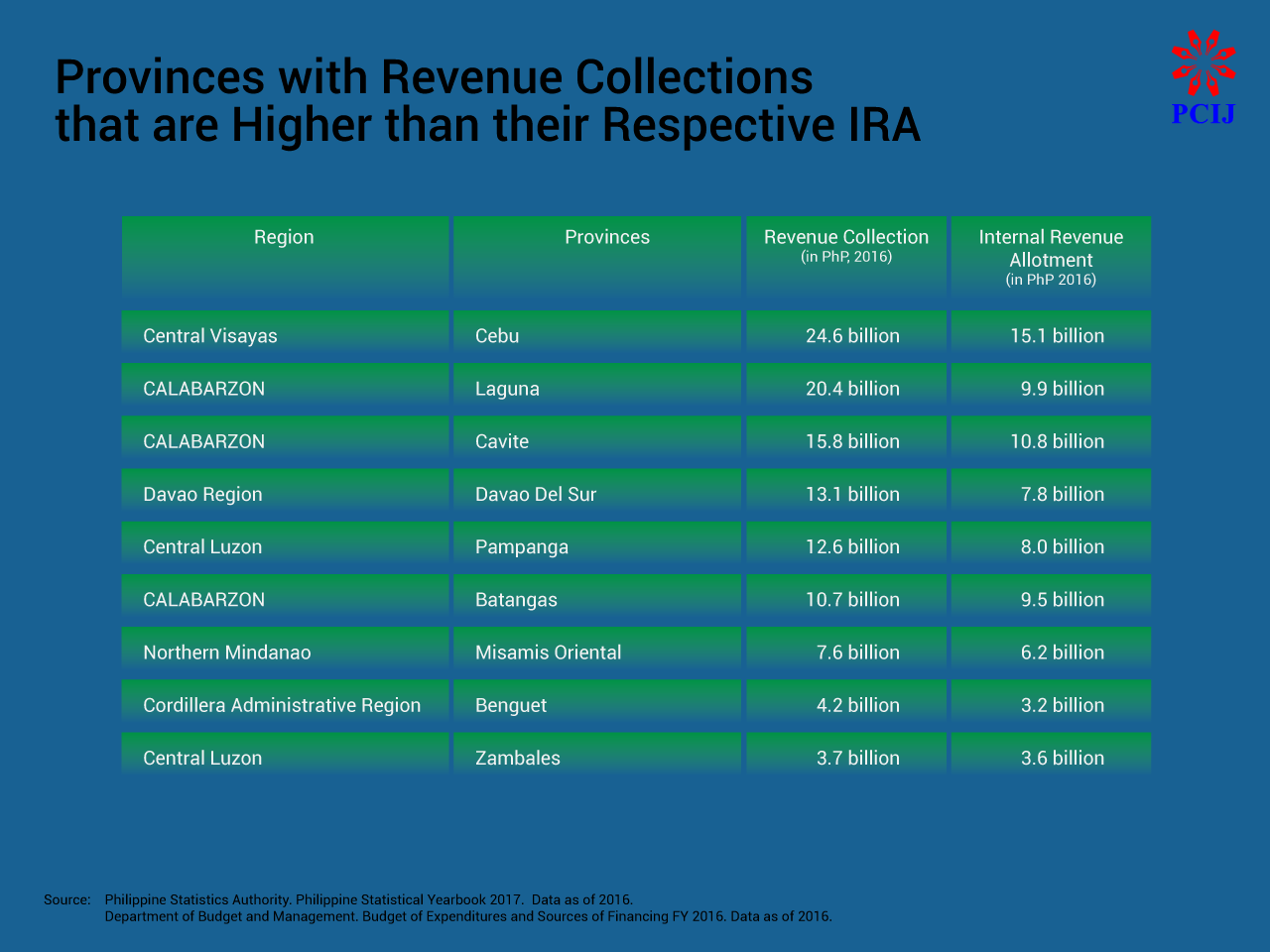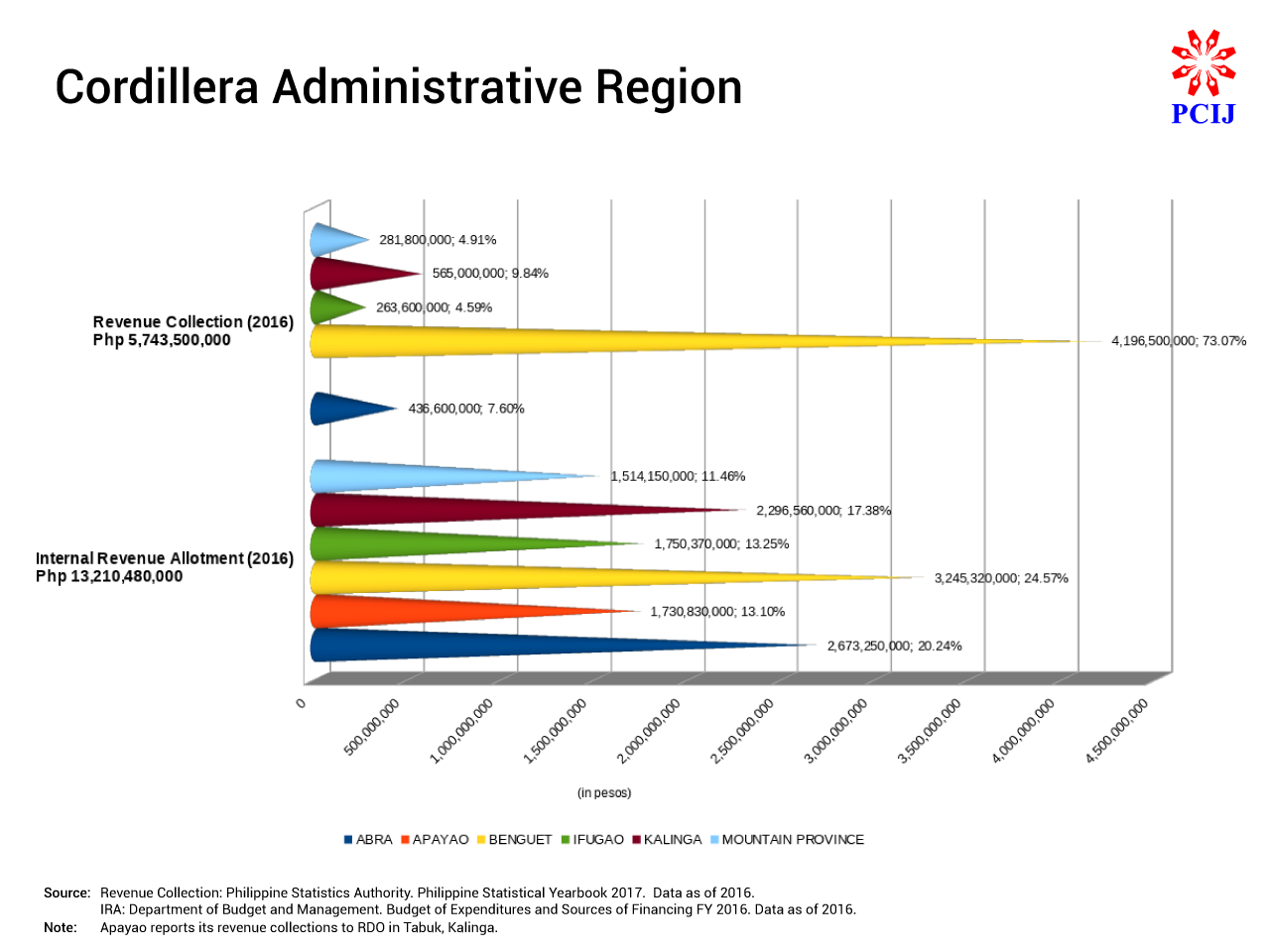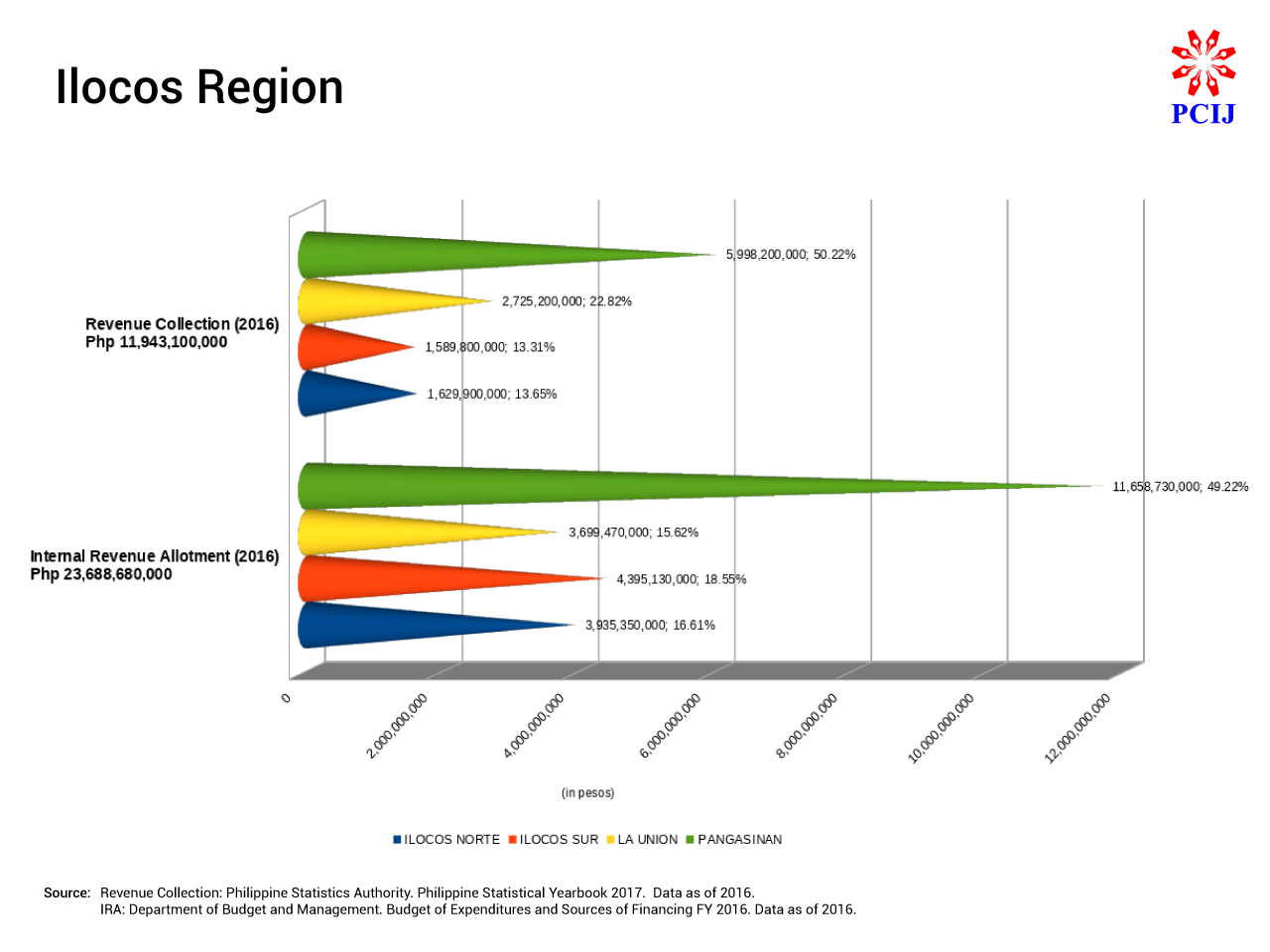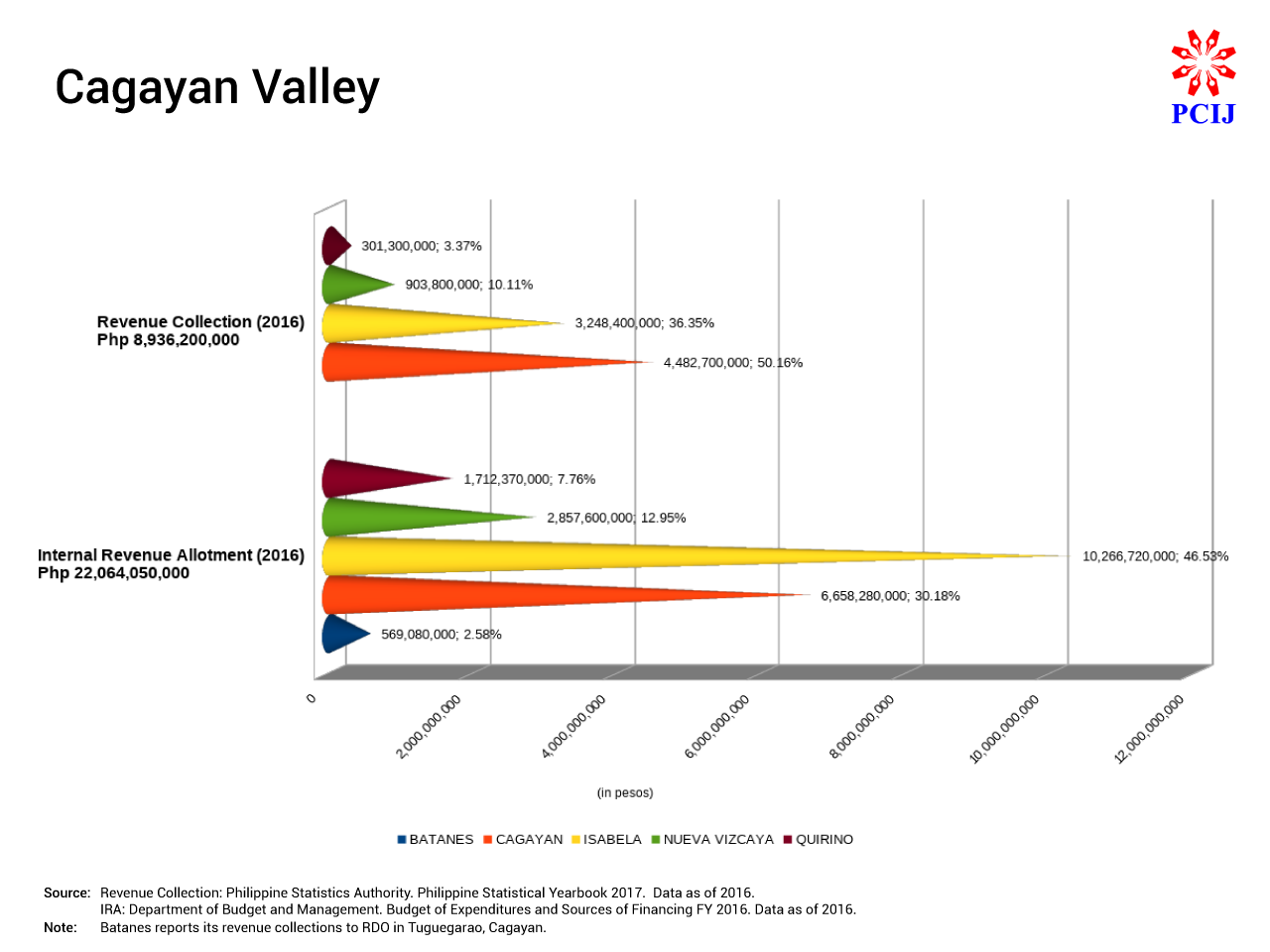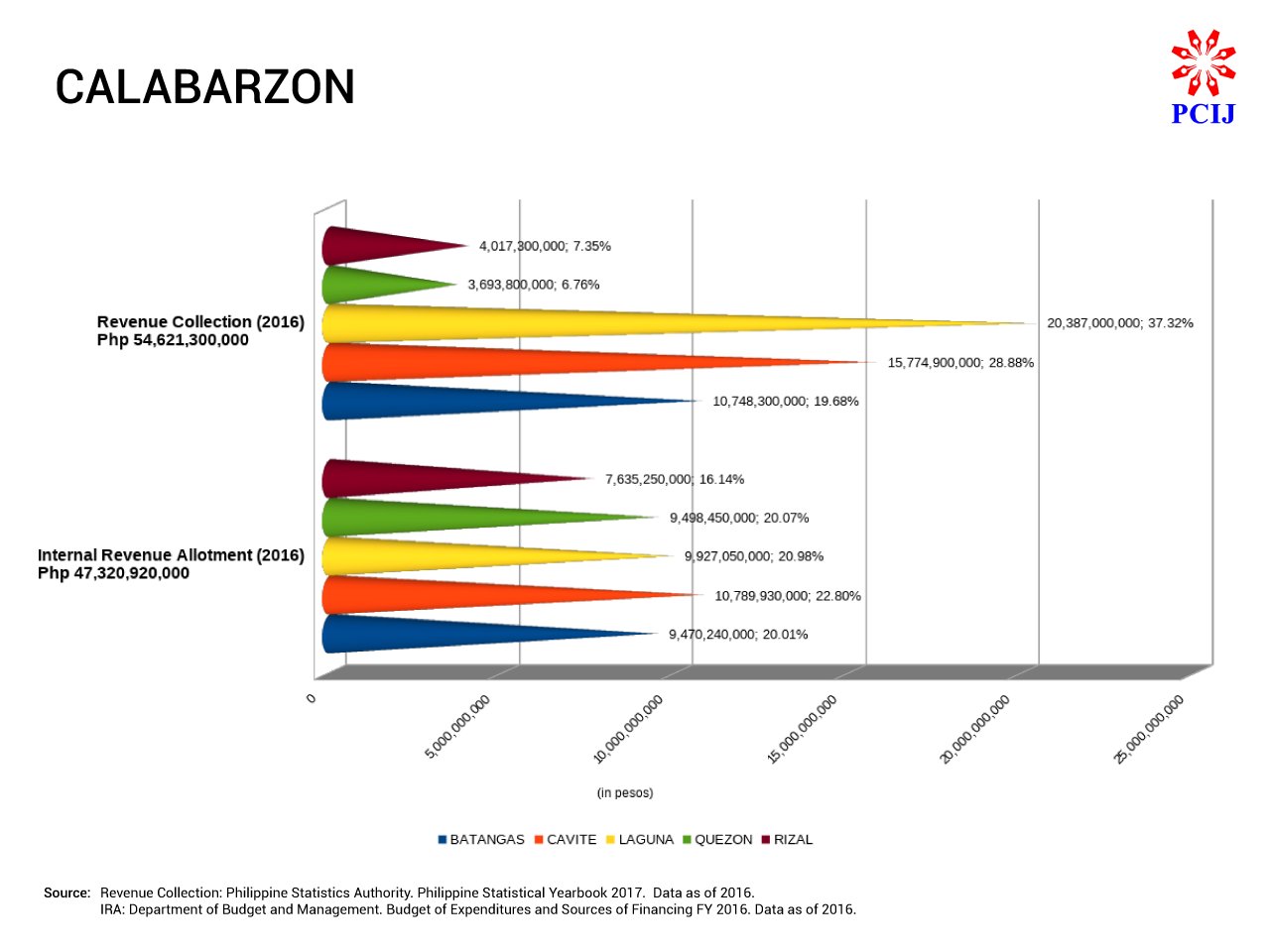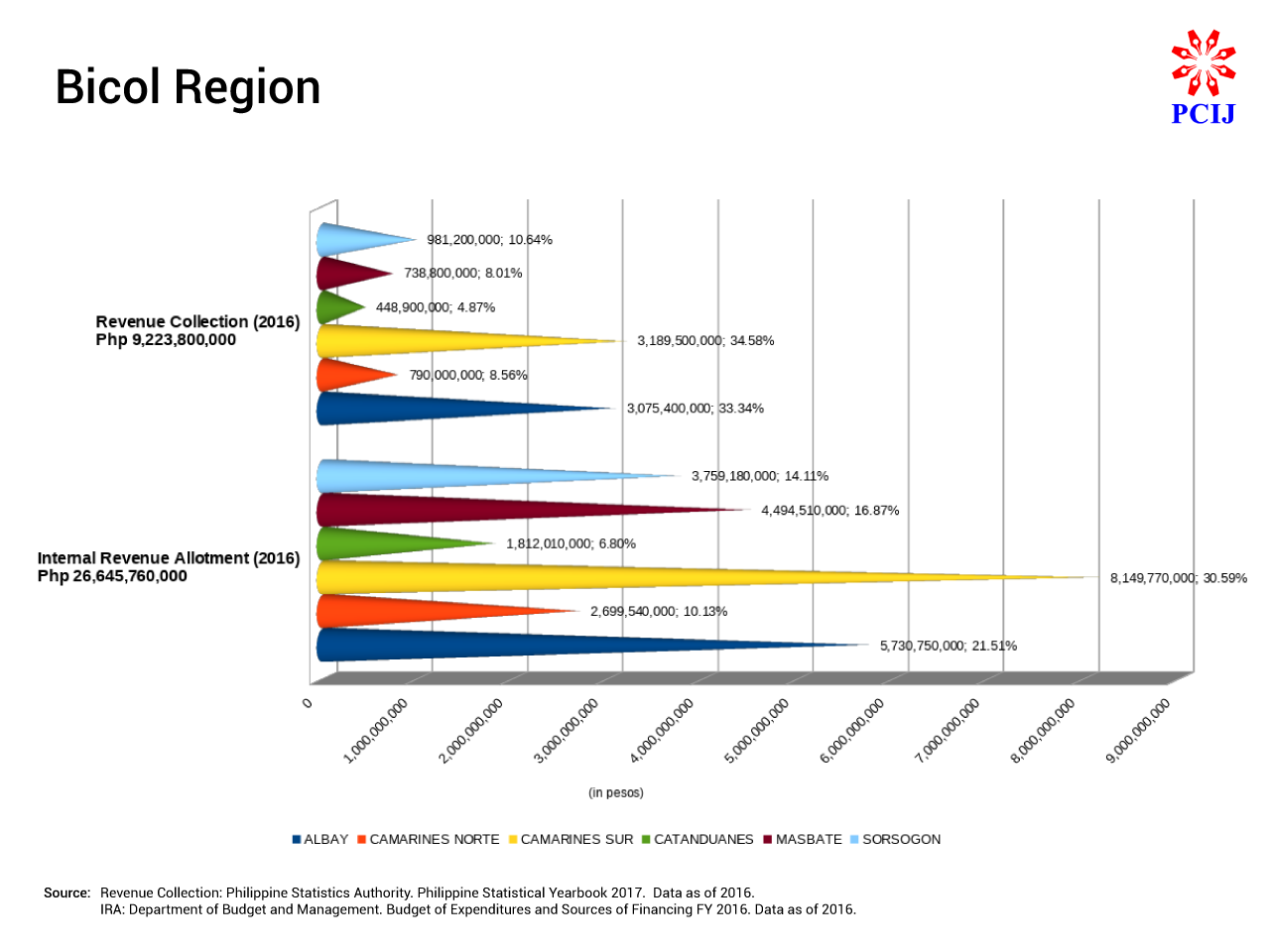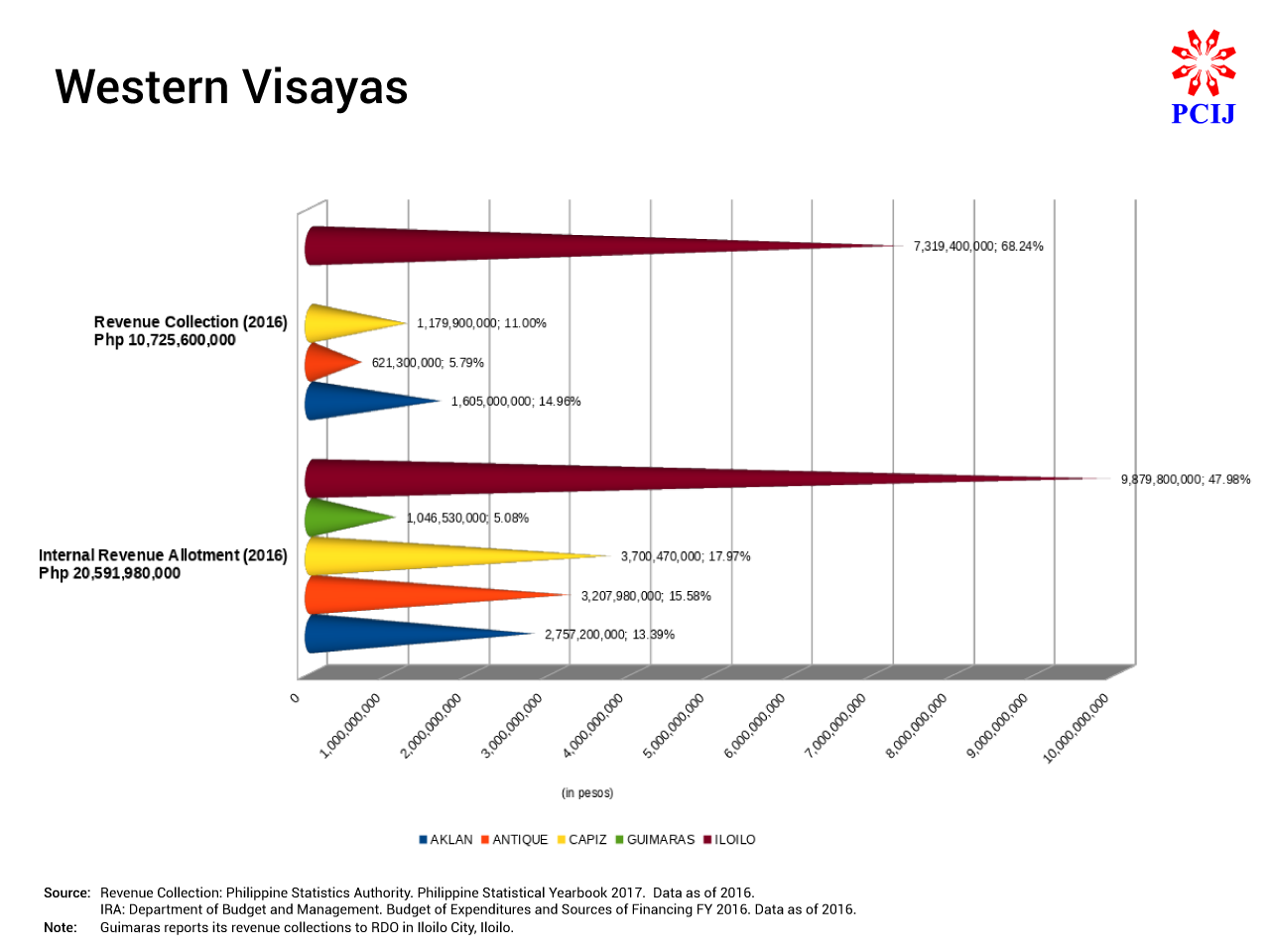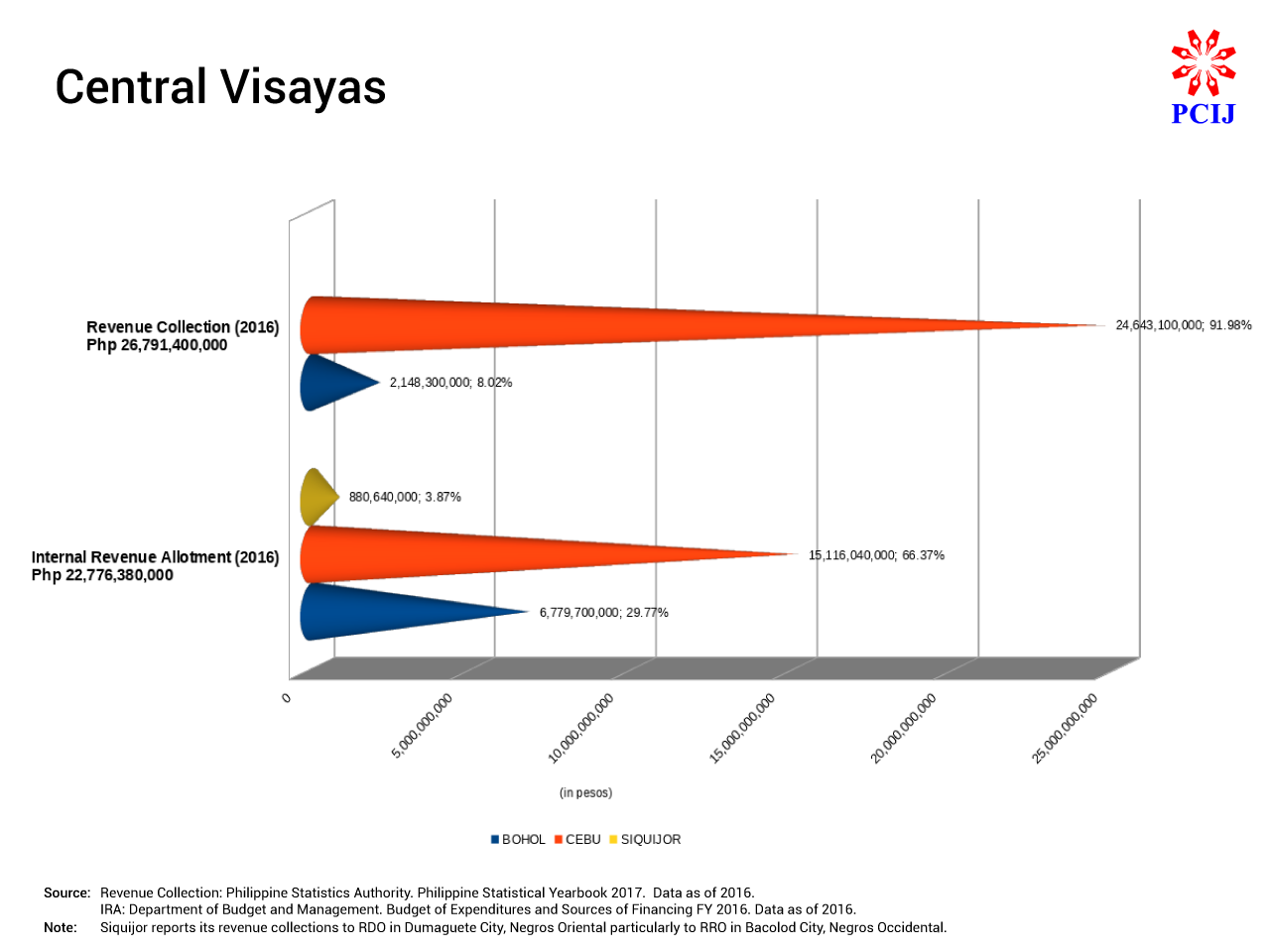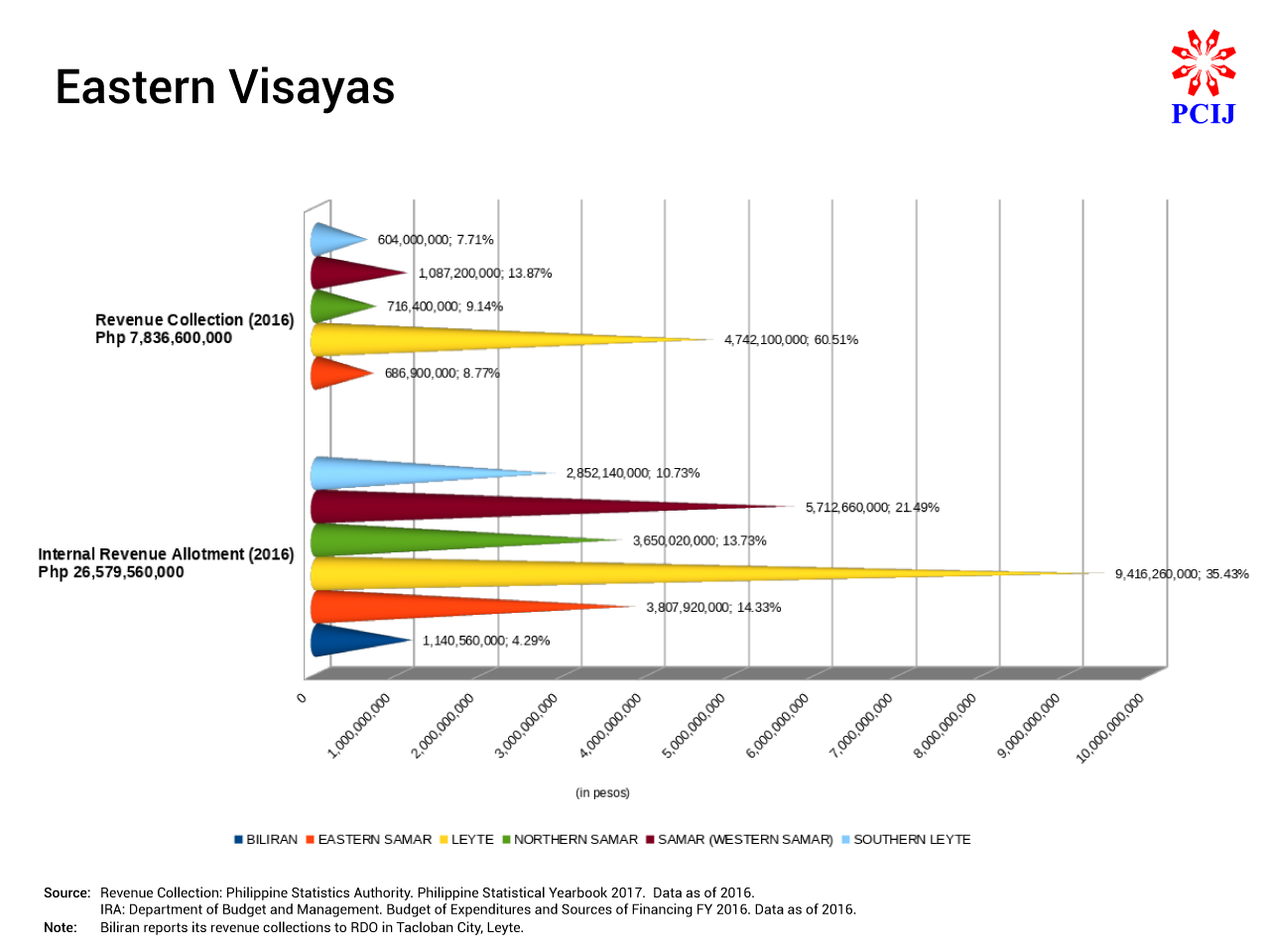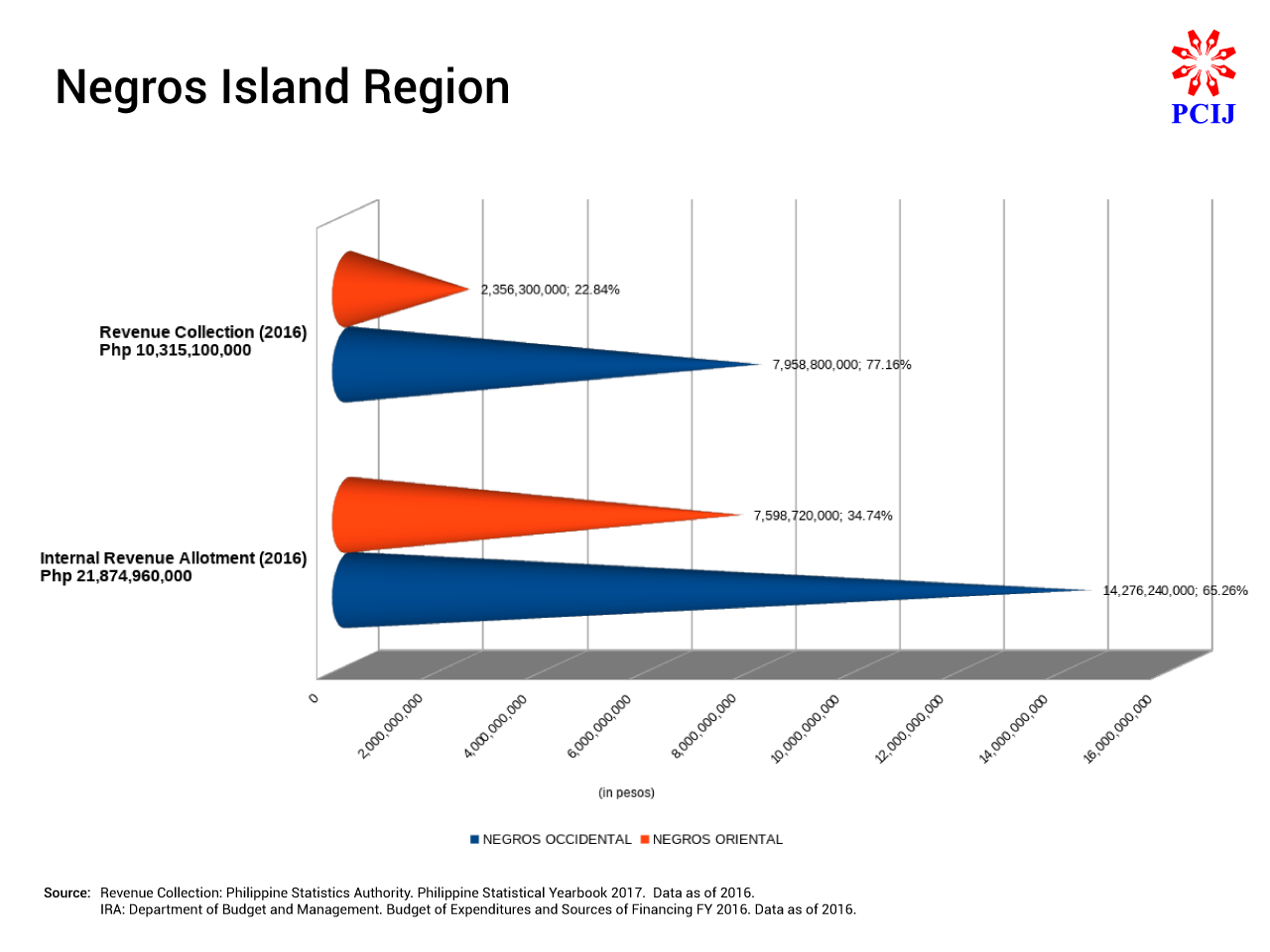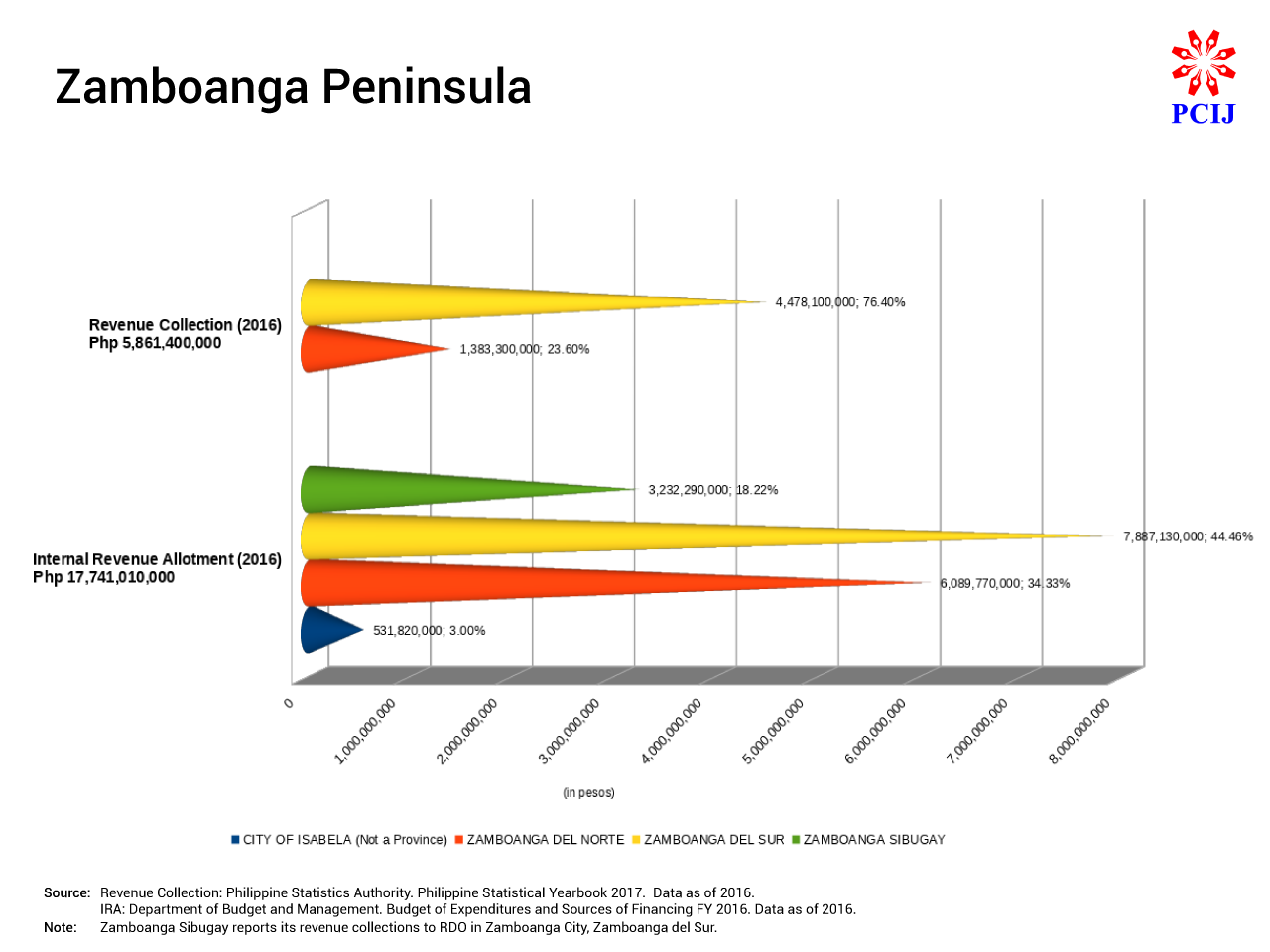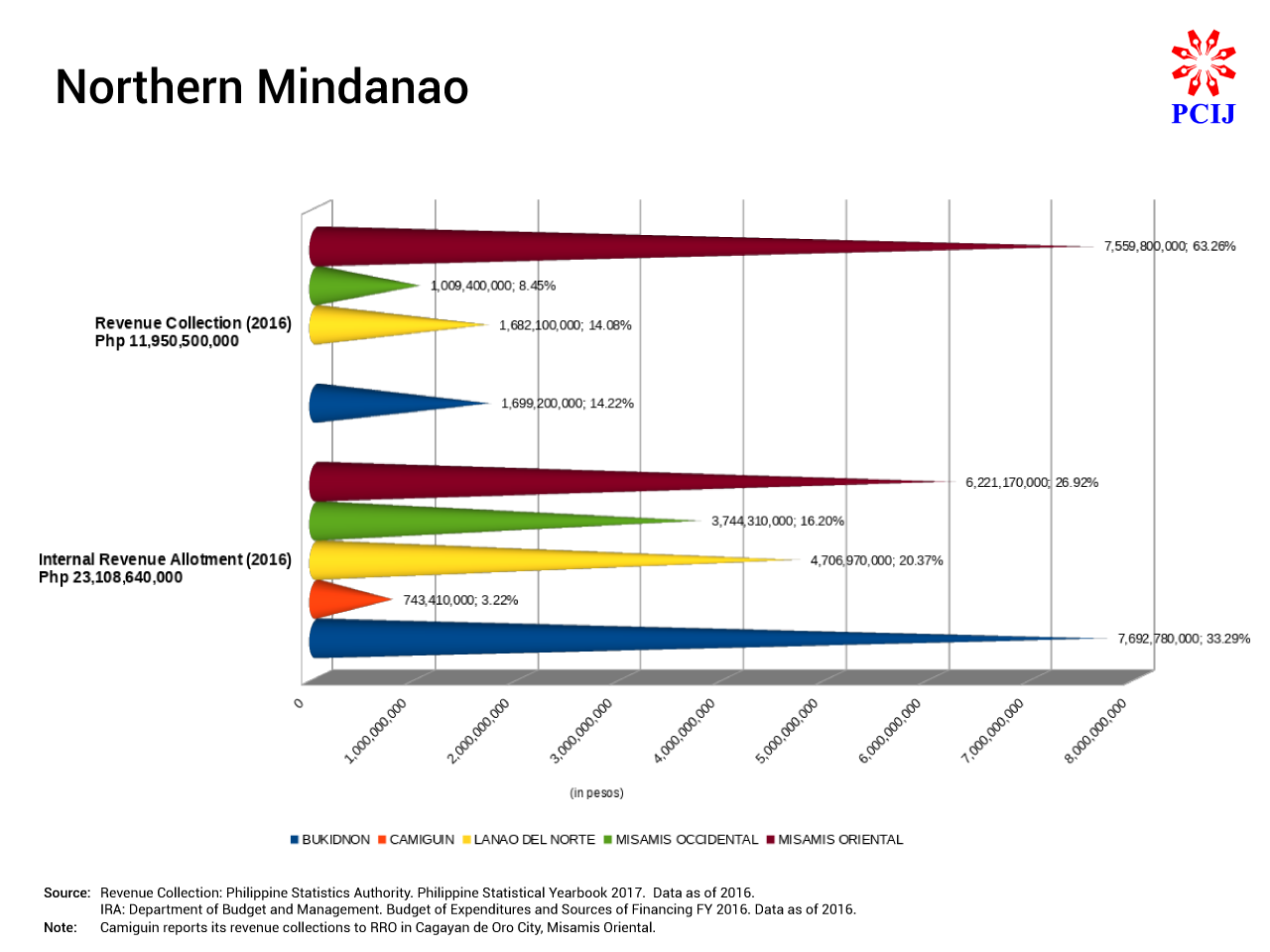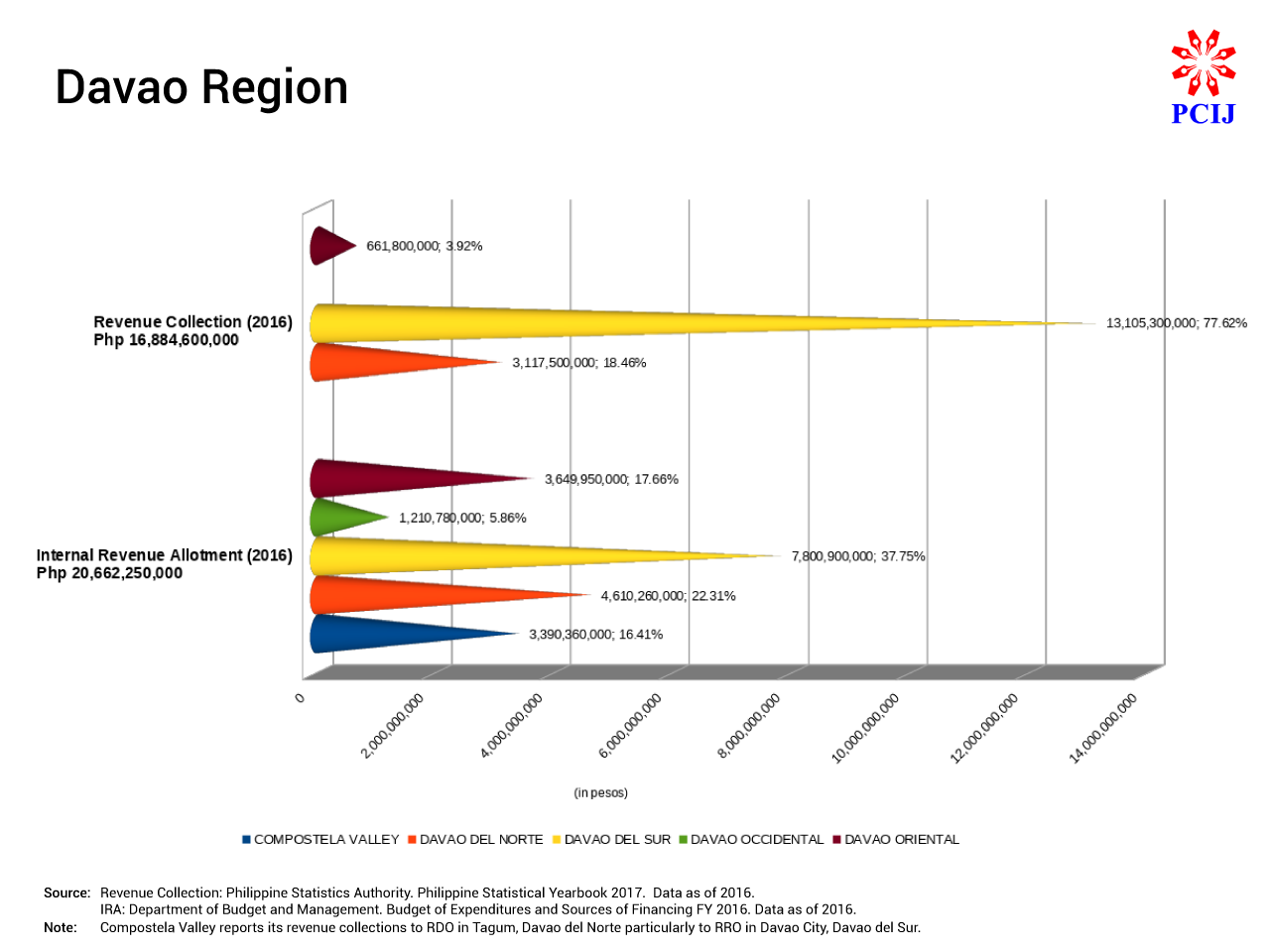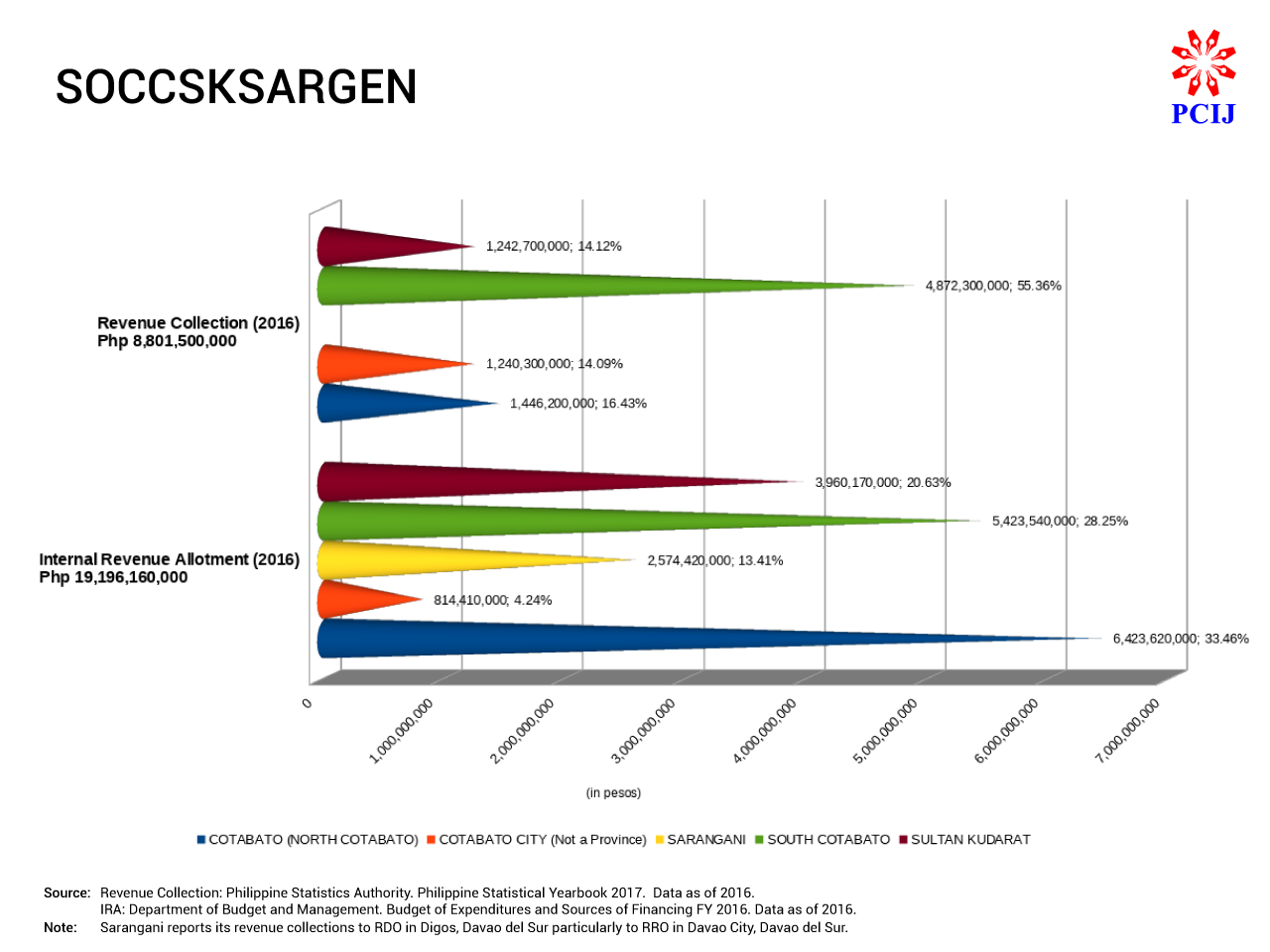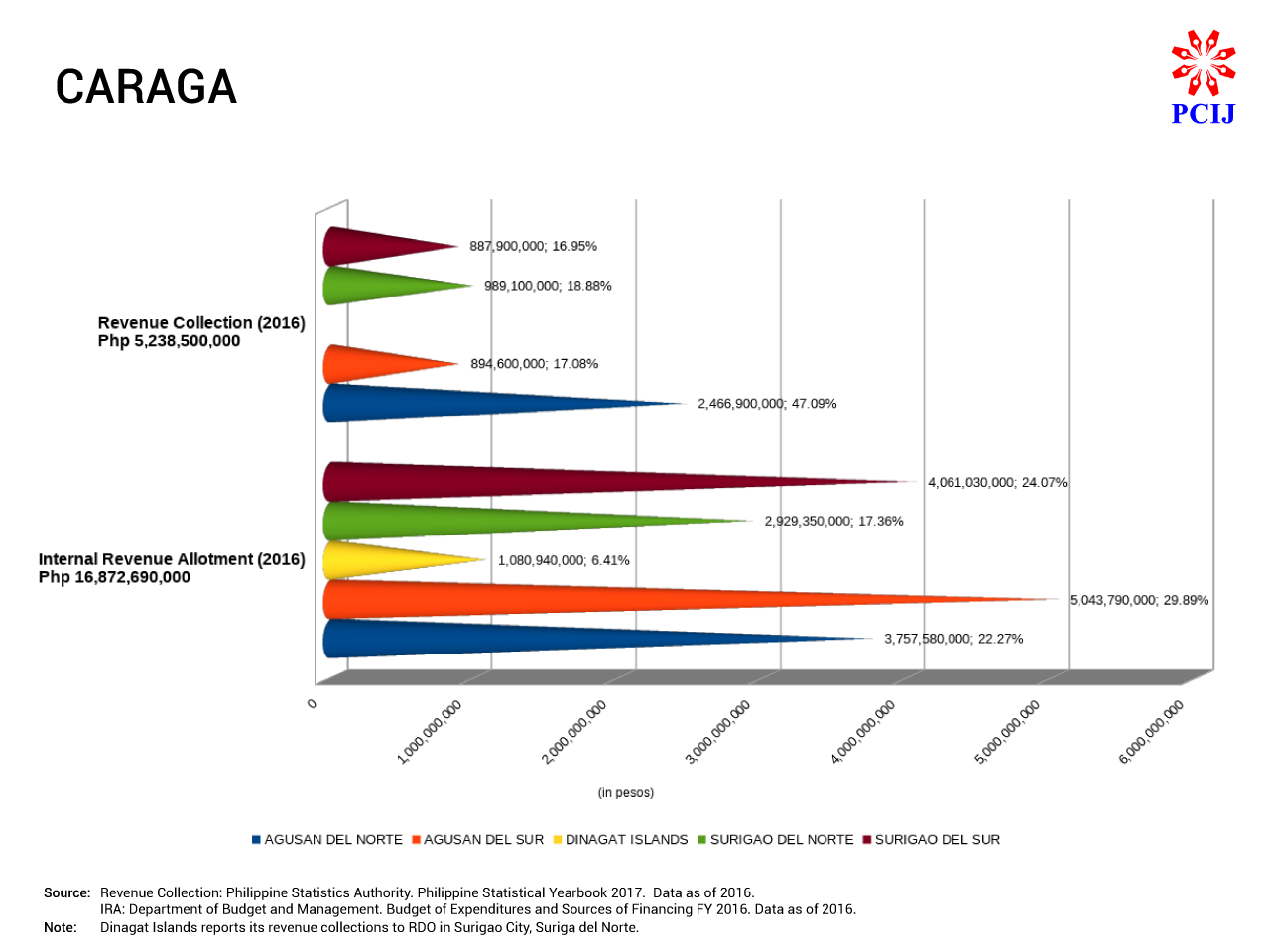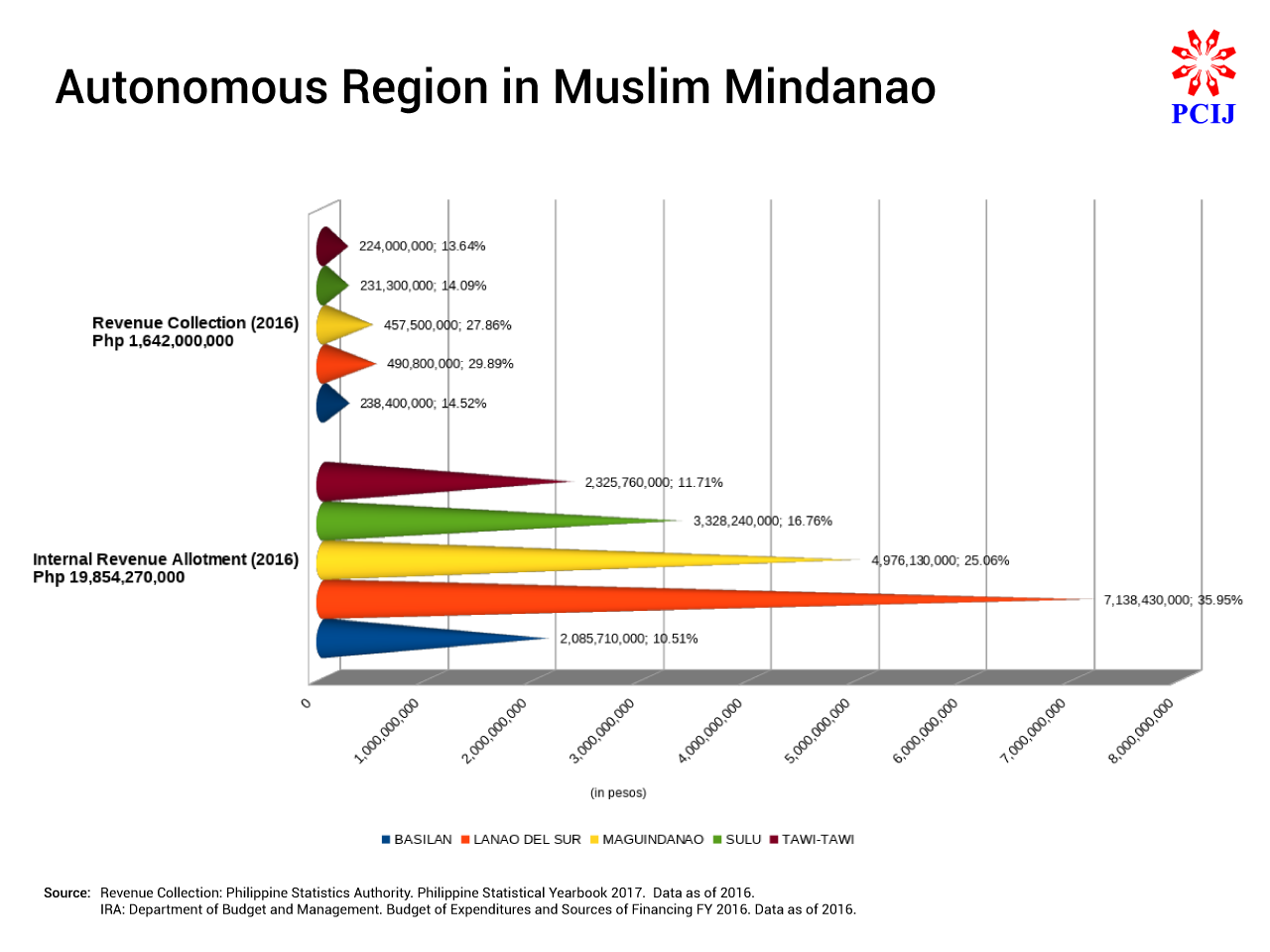ONLY THREE of the proposed 18 federated regions have revenue collections larger than the fund transfers that they are getting from the national government in terms of Internal Revenue Allotment or IRA.
The rest of the 15 regions remain largely dependent on their IRA shares to sustain their most basic operations.
The three regions with strong to significant fighting chance to take the path to fiscal autonomy in the pitch to shift to a federal system of government are the National Capital Region (Metro Manila), CALABARZON, and Central Visayas.
The presence of bustling centers of business, finance, commerce, trade, and industry in their areas are their common competitive advantage.
And because they similarly host large populations, the three regions have also consistently received bigger shares of IRA from the national government.
Data from the Bureau of Internal Revenue, Philippine Statistics Authority (PSA), and Department of Budget and Management (DBM) show that these three regions had revenue collections that were large enough to cover for their respective IRAs in 2016.
Of the country’s 81 provinces, only nine raised revenue collections large enough to cover for their respective IRAs in 2016. These are Laguna, Cebu, Davao Del Sur, Cavite, Pampanga, Misamis Oriental, Batangas, Benguet, and Zambales.
The Local Government Code of 1991 (Republic Act No. 7160) required national government to remit IRA shares to local government units (provinces, chartered cities, component cities, municipalities, and barangays) every budget year.
The IRA is the annual share of local governments out of the proceeds from national internal revenue taxes. “It is estimated at forty percent (40%) of the actual collections of national internal revenue taxes during the third fiscal year preceding the current year, as certified by the Bureau of Internal Revenue (BIR),” according to DBM circulars.
It adds that the following national internal revenue taxes are being used as bases for the computation of IRA: income tax, estate tax and donor’s tax, value-added tax, other percentage taxes, and taxes imposed by special laws, such as travel tax.
SOURCES OF REVENUE
Various revenue sources raise funds for the Philippine government — taxes, tariffs, income from government-owned and -controlled corporations, foreign aid, among others.
The government collects national taxes, the country’s primary source of revenue through BIR in various forms: income tax, estate and donor’s taxes, value-added tax, other percentage taxes, excise taxes, documentary stamp taxes, and so on.
According to the official statistics of BIR reported by PSA, the Philippine government raised a total revenue of ₱1.51 trillion in 2016.
Local government units meanwhile collect local taxes such as real property tax, municipal tax on business, community tax, among others, and do not have to remit or report these to the natonal government.
Among the 18 proposed federated regions, the National Capital Region (Metro Manila) accounts for the largest revenue collection. In 2016 alone, it raised PhP1.27 trillion worth of national taxes or 84.24 percent of the country’s total revenue collection for that year.
In contrast, in 2016 the Autonomous Region in Muslim Mindanao raised the smallest at PhP1.64 billion, or 0.11 percent of the national total.
Among the 81 provinces, Cebu ranks No. 1 in revenue collection, with its haul in 2016 reaching P24.6 billion.
Next in the Top 5 revenue-rich provinces is Laguna with PhP20.4 billion, then Cavite with PhP15.8 billion, Davao del Sur PhP13.1 billion, and Pampanga PhP12.8 billion.
The cellar dwellers in the 2016 revenue roster are Tawi-Tawi with PhP224 million, then Sulu with PhP231 million, Basilan PhP238 million, Marinduque PhP263 million, and Ifugao PhP264 million.
INTERNAL REVENUE ALLOTMENT
Internal Revenue Allotment (IRA) refers to a local government unit’s share of revenue from the national government.
The sharing scheme has been prescribed in the Local Government Code of 1991 according to a fixed formula. Every province, city, municipality, and barangay will get an IRA proportional to their respective population, land area, and an equal-sharing provision. Thus, LGUs with larger populations and land areas tend to receive larger IRA shares than their smaller counterparts.
Official data from the Philippine Statistics Authority (PSA) and the Department of Budget and Management (DBM) show that in 2016, the national government allocated PhP429 billion of its revenue to LGUs in the country, with roughly 51 percent going to LGUs in Luzon, 21 percent to LGUs in the Visayas, and 27 percent to LGUs in Mindanao.
The IRA share that year of CALABARZON was the largest at PhP47.3 billion (11.04 percent of total IRA), while the Cordillera Administrative Region (CAR) received the smallest at PhP13.2 billion (3.08 percent of total IRA).
Metro Manila received PhP27 billion, or nearly percent that received by CALABARZON. Next in terms of IRA size was Cebu at PhP15.1 billion, followed by Negros Occidental at PhP14.3 billion, Pangasinan at PhP11.7 billion, Cavite at PhP10.8 billion, and Isabela at PhP10.3 billion.
Batanes received the smallest IRA share: PhP569 million.
Also getting slivers of the IRA pie were Camiguin with PhP743 million, Siquijor PhP881 million, Guimaras PhP1.05 billion, and Dinagat Islands at PhP1.08 billion.
THE IRA AND REVENUES OF THE REGIONS
National Capital Region
Fast Facts, as of 2016 data (Rank among 18 regions):
Revenue Collection: PhP1.27 trillion, 84.24% of PH total (No.1)
Internal Revenue Allotment: PhP27.0 billion, 6.30% of PH total (No.3)
The National Capital Region will be designated as the federal capital of the Philippines. For statistical purposes, PSA grouped the 17 cities and single municipality of NCR into four districts: 1st District, City of Manila; 2nd District, Mandaluyong City, Marikina City, Pasig City, Quezon City, San Juan City; 3rd District, Caloocan City, Malabon City, Navotas City, Valenzuela City; and 4th District, Las Pinas City, Makati City, Muntinlupa City, Paranaque City, Pasay City, Pateros, and Taguig City.
As the nation’s primary center of finance and development, NCR is the national government’s largest source of tax revenues. In 2016, NCR raised PhP1.27 trillion worth of national taxes (84.2 percent of the country’s total revenue collection).
Having the second largest population among the regions, NCR also received the third largest IRA at PhP27 billion (6.30 percent of the country’s total IRA) in 2016.
NCR is also one of the three proposed federated regions with total revenue collection large enough to cover for its IRA, apart from CALABARZON and Central Visayas.
Cordillera Administrative Region
Fast Facts, as of 2016 data (Rank among 18 regions):
Revenue Collection: PhP5.7 billion, 0.38% (No.15)
Internal Revenue Allotment: PhP13.2 billion, 3.08% (No. 18)
The Cordillera Administrative Region will comprise the provinces of Abra, Benguet, Ifugao, Kalinga, Apayao, and Mountain Province.
Among the proposed federated regions, CAR raised the fourth smallest revenue in 2016 at PhP5.7 billion (0.38 percent of the country’s total revenue collection). Having the smallest population among the proposed federated regions, CAR also received the lowest IRA among them at PhP13.2 billion (3.08 percent of the country’s total IRA).
In 2016, Benguet raised the largest tax revenue among the CAR provinces at PhP4.2 billion (73 percent of CAR’s total revenue collection). Kalinga raised the second largest at PhP565 million, followed by Abra at PhP437 million, Mountain Province at PhP282 million, and Ifugao at PhP264 million. Apayao reports its revenue collection to the Revenue District Office in Tabuk, Kalinga.
Benguet also received the largest IRA among the CAR provinces in CAR at PhP3.25 billion (25 percent of CAR’s total IRA), followed by Abra at PhP2.67 billion (20 percent), Kalinga at PhP2.3 billion (17 percent), Ifugao at PhP1.75 billion (13 percent), Apayao at PhP1.73 billion (13 percent), and Mountain Province, at PhP1.51 billion (11 percent) in 2016.
Benguet is the only province in CAR and one of only nine provinces in the country with a revenue collection higher than its IRA. In 2016, it collected revenue amounting to PhP4.2 billion while its IRA reached only PhP3.25 billion. The highly urbanized city of Baguio is located in Benguet.
Ilocos Region
Fast Facts, as of 2016 data (Rank among 18 regions):
Revenue Collection: PhP11.9 billion, 0.79% (No.7)
Internal Revenue Allotment: PhP23.7 billion, 5.53% (No.6)
The proposed federated region of Ilocos will comprise the current Region I provinces: Ilocos Norte, Ilocos Sur, La Union, and Pangasinan.
Among the proposed federated regions, Ilocos Region raised the seventh largest revenue in 2016 at PhP11.9 billion (0.79 percent of the region’s total revenue collection) and received the sixth largest IRA at PhP23.7 billion (5.53 percent of the country’s total IRA).
In 2016, Pangasinan raised the largest tax revenue among the provinces in the Ilocos Region, at PhP6 billion (50 percent of the region’s total revenue collection), followed by La Union at PhP2.73 billion (23 percent), Ilocos Norte at PhP1.63 billion (14 percent), and Ilocos Sur at PhP1.59 billion (13 percent).
Pangasinan also received the largest share of the region’s IRA, and the third largest in the country, in 2016, getting PhP11.7 billion (49 percent of Ilocos Region’s total IRA), followed by Ilocos Sur with PhP4.4 billion (19 percent), Ilocos Norte PhP3.94 billion (17 percent), and La Union PhP3.7 billion (16 percent).
Cagayan Valley
Fast Facts, as of 2016 data (Rank among 18 regions):
Revenue Collection: PhP8.9 billion, 0.59% (No.11)
Internal Revenue Allotment: PhP22.1 billion, 5.15% (No.9)
The proposed federated region of Cagayan Valley will comprise the current Region II provinces: Batanes, Cagayan, Isabela, Nueva Vizcaya, and Quirino.
Among the 18 proposed federated regions, Cagayan Valley raised the eighth smallest tax revenue in 2016 at PhP8.9 billion (0.59 percent of the country’s total revenue collection) and received the ninth largest IRA at PhP22 billion (5.15 percent of the country’s total IRA).
Cagayan raised the largest tax revenue among the region’s provinces at PhP4.48 billion (50 percent of the region’s total revenue collection), followed by Isabela at PhP3.25 billion (36 percent), Nueva Vizcaya at PhP904 million (10 percent), and Quirino at PhP301 million (three percent). Batanes reports its revenue collection to the Revenue District Office in Tuguegarao, Cagayan.
Meanwhile, Isabela received the largest IRA among the provinces in Cagayan Valley, and the fifth largest in the country at PhP10.3 billion (47 percent of the region’s total IRA) in 2016, followed by Cagayan at PhP6.66 billion (30 percent), Nueva Vizcaya PhP2.86 billion (13 percent), and Quirino PhP1.71 billion (eight percent).
Batanes received the smallest IRA not just among the provinces in the region, but also in the country at PhP569 million (three percent of the region’s total IRA).
Central Luzon
Fast Facts, as of 2016 data (Rank among 18 regions):
Revenue Collection: PhP35.8 billion, 2.37% (No. 3)
Internal Revenue Allotment: PhP40.7 billion, 9.51% (No.2)
Central Luzon region will comprise the provinces in the current Region III: Aurora, Bataan, Bulacan, Nueva Ecija, Pampanga, Tarlac, and Zambales.
Among the proposed federated regions, Central Luzon raised the third largest revenue at PhP35.8 billion (2.37 percent of the country’s total revenue collection) and received the second largest IRA at PhP40.7 billion (9.51 percent of the country’s total IRA) in 2016.
Two provinces in the region managed to raise tax revenues large enough to cover for their respective IRAs. Pampanga raised the fifth largest revenue collection in the country at PhP12.8 billion, and received the third largest IRA at PhP8.01 billion across Central Luzon. Zambales raised PhP3.73 billion and received PhP3.63 billion. The highly-urbanized cities of Angeles and Olongapo are located in Pampanga and Zambales, respectively.
Among the region’s provinces, Pampanga’s revenue in 2016 was also the highest among the region’s provinces and was equivalent to 36 percent of Central Luzon’s total revenue collection. This was followed by Bulacan at PhP9.73 billion (27 percent), Nueva Ecija at PhP3.86 billion (11 percent), Zambales (10 percent), Tarlac at PhP2.87 billion (8.0 percent), and Bataan at PhP2.54 billion (7.1 percent). Aurora had the smallest revenue at PhP344 million (1.0 percent).
In terms of IRA allotment, Bulacan received the largest at PhP9.91 billion (24 percent of the region’s total IRA), followed by Nueva Ecija at PhP9.13 billion (22 percent), Pampanga (20 percent), Tarlac at PhP5.26 billion (13 percent), Zambales (8.9 percent), and Bataan at PhP3.04 billion (7.5 percent).
Aurora received the smallest IRA that year at PhP1.77 billion (4.3 percent).
CALABARZON
Fast Facts, as of 2016 data (Rank among 18 regions):
Revenue Collection: PhP54.6 billion, 3.62% (No.2)
Internal Revenue Allotment: PhP47.3 billion, 11.04% (No. 1)
The proposed federated region of CALABARZON will comprise the current provinces in the current Region IV-A: Cavite, Laguna, Batangas, Rizal, and Quezon.
Among the proposed federated regions, CALABARZON raised the second largest revenue at PhP54.6 billion (3.62 percent of the country’s total revenue collection), and received the largest IRA, at PhP47.3 billion (11.04 percent of the country’s total IRA) in 2016.
CALABARZON is also one of the three proposed federated regions with total revenue collections large enough to cover for their IRAs.
Three provinces in CALABARZON managed to raise in 2016 tax revenues large enough to cover for their respective IRAs: Laguna raised the second largest revenue collection in the country at PhP20.4 billion, and received an IRA of PhP9.93 billion; Cavite raised the third largest revenue collection in the country at PhP15.8 billion and received the fourth largest IRA in the country at PhP10.8 billion; and Batangas raised PhP10.7 billion and received PhP9.47 billion.
Among the provinces in CALABARZON, Laguna also raised the largest revenue in 2016, which was equivalent to 37.3 percent of the region’s total revenue collection. Next came Cavite, whose revenue was equivalent to 28.9 percent of the region’s total, followed Batangas (19.7 percent), Rizal at PhP4.02 billion (7.4 percent), and Quezon at PhP3.69 billion (6.8 percent).
It was Cavite, however, which received the largest IRA among the CALABARZON provinces in 2016, with its share at 22.8 percent of the region’s total IRA). This was followed by Laguna (21.0 percent) and then Quezon, which received PhP9.50 billion (20.1 percent). Batangas was fourth in terms of IRA share (20.0 percent). Getting the smallest IRA was Rizal at PhP7.64 billion (16.1 percent).
MIMAROPA
Fast Facts, as of 2016 data (Rank among 18 regions):
Revenue Collection: PhP5.4 billion, 0.36% (No.16)
Internal Revenue Allotment: PhP18.7 billion, 4.36% (No.15)
The proposed federated region of MIMAROPA will comprise the current Region IV-B provinces: Occidental Mindoro and Oriental Mindoro, Marinduque, Romblon, and Palawan.
In 2016, MIMAROPA raised the third smallest revenue among the proposed federated regions at PhP5.4 billion (0.36 percent of the country’s total revenue collection) and received the fourth smallest IRA at PhP18.7 billion (4.36 percent of the country’s total IRA).
Palawan topped MIMAROPA’S provinces in terms of revenue collection, raising PhP2.86 billion (53.0 percent of the region’s total revenue collection), followed by Oriental Mindoro at PhP1.28 billion (23.8 percent), Occidental Mindoro PhP608 million (11.3 percent), and Romblon at PhP375 million (7.0 percent). Bringing up the rear was Marinduque, with PhP263 million (4.9 percent).
Palawan also received the largest IRA among the provinces in MIMAROPA in 2016: PhP8.13 billion or 43.5 percent of the region’s total IRA). Next came Oriental Mindoro with PhP4.15 billion (22.2 percent), Occidental Mindoro PhP3.03 billion (16.2 percent), Romblon PhP2.00 billion (10.5 percent), and Marinduque PhP1.42 billion (7.6 percent).
Bicol Region
Fast Facts, as of 2016 data (Rank among 18 regions):
Revenue Collection: PhP9.2 billion, 0.61% (No.10)
Internal Revenue Allotment: PhP26.6 billion, 6.22% (No.4)
The proposed federated region of Bicol will comprise the current Region V provinces: Albay, Camarines Norte, Camarines Sur, Catanduanes, Masbate, and Sorsogon.
Bicol raised the tenth smallest revenue among the proposed federated regions in 2016, at PhP9.22 billion (0.61 percent of the country’s total revenue collection). But it also received the fourth largest IRA: PhP26.6 billion or 6.22 percent of the country’s total IRA.
Among the provinces in Bicol, Camarines Sur had the largest revenue that year at PhP3.19 billion (35 percent of Bicol’s total revenue collection), followed by Albay at PhP3.08 billion (33 percent), Sorsogon PhP981 million (11 percent), Camarines Norte PhP790 million (nine percent), and Masbate at PhP739 million (eight percent). Catanduanes raised the smallest revenue that year, with PhP440 million (five percent).
Camarines Sur also received the largest IRA among the provinces in Bicol in 2016 at PhP8.15 billion (31 percent of Bicol’s total IRA), followed by Albay at PhP5.73 billion (22 percent), Masbate PhP4.49 billion (17 percent), Sorsogon PhP3.76 billion (14 percent), Camarines Norte PhP2.70 billion (10 percent), and Catanduanes PhP1.81 billion (seven percent).
Western Visayas
Fast Facts, as of 2016 data (Rank among 18 regions):
Revenue Collection: PhP10.7 billion, 0.71% (No.8)
Internal Revenue Allotment: PhP20.6 billion, 4.80% (No.12)
The proposed federated region of Western Visayas will comprise five of the six provinces in the current Region VI: Aklan, Antique, Capiz, Guimaras, and Iloilo.
Western Visayas in 2016 raised the eighth largest revenue among the proposed 18 federated regions at PhP10.7 billion (0.71 percent of the country’s total revenue collection), but received the seventh smallest IRA at PhP20.6 billion (4.80 percent of the country’s total IRA).
Among the provinces in Western Visayas, Iloilo raised the largest tax revenue at PhP7.32 billion (68 percent), followed by Aklan at PhP1.61 billion (15 percent), Capiz PhP1.18 billion (11 percent), and Antique at PhP621 million (six percent). Guimaras reports its revenue collection to the Revenue District Office in Iloilo City, Iloilo.
Iloilo also received the largest IRA among the provinces in Western Visayas in 2016 at PhP9.88 billion (48 percent of the region’s total IRA), followed by Capiz at PhP3.70 billion (18 percent), Antique PhP3.21 billion (16 percent), and Aklan PhP2.76 billion (13 percent).
Guimaras that year received the smallest IRA in the region, and the fourth smallest in the country, getting PhP1.05 billion (five percent of the region’s total IRA).
Central Visayas
Fast Facts, as of 2016 data (Rank among 18 regions):
Revenue Collection: PhP26.8 billion, 1.78% (No. 4)
Internal Revenue Allotment: PhP22.8 billion, 5.31% (No.8)
The proposed federated region of Central Visayas will have three of the four provinces in the current Region VII: Bohol, Cebu, and Siquijor.
Among the proposed federated regions, Central Visayas raised the fourth largest revenue at PhP26.8 billion (1.78 percent of the country’s total revenue collection) and received the eighth largest IRA at PhP22.8 billion (5.31 percent of the country’s total IRA) in 2016.
Central Visayas is also one of the three proposed federated regions with a total revenue collection that was large enough to cover for its IRA.
Among the provinces in Central Visayas, Cebu raised the largest revenue in 2016 at PhP24.6 billion, or 92 percent of the region’s total revenue collection. Bohol collected a far lower PhP2.15 billion (eight percent). The province of Siquijor reports its revenue collection to the Revenue District Office in Dumaguete City, Negros Oriental.
Cebu as well received the largest IRA among the provinces in Central Visayas in 2016 at PhP15.1 billion (66 percent of the region’s total IRA), followed by Bohol at PhP6.78 billion (30 percent). Siquijor received the smallest IRA – also the third smallest in the country – at PhP881 million (four percent of the region’s total IRA).
Cebu is the only province in Central Visayas (and in the Visayas group of islands) and one of only nine provinces in the country with revenue collections higher than their IRA shares.
In 2016, Cebu raised the largest revenue collection among the provinces nationwide at PhP24.6 billion and received the largest IRA at PhP15.1 billion.
The highly-urbanized cities of Cebu, Lapu-Lapu, and Mandaue, as well as their surrounding cities and municipalities, make up Metro Cebu.
Eastern Visayas
Fast Facts, as of 2016 data (Rank among 18 regions):
Revenue Collection: PhP7.8 billion, 0.52% (No.13)
Internal Revenue Allotment: PhP26.6 billion, 6.20% (No.5)
Eastern Visayas will comprise the provinces in the current Region VIII: Eastern Samar, Northern Samar, Western Samar, Leyte, Southern Leyte, and Biliran.
Eastern Visayas in 2016 raised the sixth smallest tax revenue among the proposed federated regions, at PhP7.8 billion (0.52 percent of the country’s total revenue collection), but received the fifth largest IRA, PhP26.6 billion (6.20 percent of the country’s total IRA).
Among the provinces in Eastern Visayas, Leyte raised the largest revenue at PhP4.74 billion (60.5 percent of the region’s total revenue collection), followed by Western Samar at PhP1.09 billion (13.9 percent), Northern Samar PhP716 million (9.1 percent), Eastern Samar PhP687 million (8.8 percent), and Southern Leyte PhP604 million (7.7 percent). The province of Biliran reports its revenue collection to the Revenue District Office in Tacloban City, Leyte.
Leyte also received the largest IRA among the provinces in Eastern Visayas in 2016, getting PhP9.42 billion (35 percent of the region’s total IRA), followed by Western Samar with PhP5.71 billion (21 percent), Eastern Samar PhP3.81 billion (14 percent), Northern Samar PhP3.65 billion (14 percent), Southern Leyte PhP2.85 billion (11 percent), and Biliran PhP1.14 billion (four percent).
Negros Island Region
Fast Facts, as of 2016 data (Rank among 18 regions):
Revenue Collection: PhP10.3 billion, 0.68% (No. 9)
Internal Revenue Allotment: PhP21.9 billion, 5.10% (No.10)
The proposed federated region of Negros Island (NIR) will comprise the provinces of Negros Occidental (formerly of Region VI) and Negros Oriental (formerly of Region VII).
NIR was previously established under former President Benigno S. Aquino III’s Executive Order No. 183 in 2015, but this was suspended by President Rodrigo R. Duterte’s EO No. 83 in 2016.
Together, the two Negros provinces raised the ninth largest revenue among the proposed federated regions at PhP10.3 billion (0.68 percent of the country’s total revenue collection). Their combined IRA of PhP21.9 billion (5.10 percent of the country’s total IRA) was also the 10th largest, surpassing other regions with more provinces.
Negros Occidental, in fact, raised the eighth largest revenue among all the provinces in the country at PhP7.96 billion, and received the second largest IRA in the country at PhP14.3 billion in 2016.
Meanwhile, Negros Oriental raised PhP2.36 billion in tax revenues and received an IRA of PhP7.6 billion in the same year.
Zamboanga Peninsula
Fast Facts, as of 2016 data (Rank among 18 regions):
Revenue Collection: PhP5.9 billion, 0.39% (No.14)
Internal Revenue Allotment: PhP17.7 billion, 4.14% (No.16)
The proposed federated region of Zamboanga Peninsula will comprise the current Region IX provinces — Zamboanga del Norte, Zamboanga del Sur, and Zamboanga Sibugay — as well as the component city of Isabela in the province of Basilan (part of ARMM).
In 2016, Zamboanga Peninsula raised the fifth smallest revenue among the proposed 18 federated regions at PhP5.9 billion (0.39 percent of the country’s total revenue collection), and received the third smallest IRA at PhP17.7 billion (4.14 percent of the country’s total IRA).
Zamboanga del Sur raised PhP4.48 billion in tax revenues, while Zamboanga del Norte raised PhP1.38 billion. Zamboanga Sibugay reports its revenue collection to the Revenue District Office in Zamboanga City, Zamboanga del Sur.
Zamboanga del Sur also received the largest IRA among the provinces in Zamboanga Peninsula in 2016 at PhP7.89 billion (44 percent of the region’s total IRA), followed by Zamboanga del Norte at PhP6.09 billion (34 percent), Zamboanga Sibugay PhP3.23 billion, and the city of Isabela PhP532 million (three percent).
Northern Mindanao
Fast Facts, as of 2016 data (Rank among 18 regions):
Revenue Collection: PhP12.0 billion, 0.79% (No. 6)
Internal Revenue Allotment: PhP23.1 billion, 5.39% (No.7)
The proposed federated region of Northern Mindanao will comprise the current Region X provinces: Bukidnon, Camiguin, Lanao del Norte, Misamis Occidental, and Misamis Oriental.
Among the proposed 18 federated regions, Northern Mindanao in 2016 raised the sixth largest revenue at PhP11.9 billion (0.79 percent of the country’s total revenue collection), and received the seventh largest IRA at PhP23.1 billion (5.39 percent of the country’s total IRA).
Misamis Oriental raised the largest revenue among the provinces in Northern Mindanao at PhP7.56 billion (63 percent of the region’s total revenue collection), followed by Bukidnon at PhP1.7 billion (14 percent), Lanao del Norte PhP1.68 billion (14 percent), and Misamis Occidental PhP1.01 billion (8 percent). Camiguin reports its revenue collection to the RRO in Cagayan de Oro City, Misamis Oriental.
Meanwhile, Bukidnon received the largest IRA among the Northern Mindanao provinces at PhP7.69 billion (33 percent of the region’s total IRA), followed by Misamis Oriental at PhP6.22 billion (27 percent), Lanao del Norte PhP4.71 billion (20 percent), Misamis Occidental PhP3.74 billion (16 percent). Camiguin received the smallest IRA in the region, and the second smallest in the country, at PhP743 million (three percent of the region’s total IRA).
Misamis Oriental is the only province in Northern Mindanao and one of only nine provinces in the country with revenue collections higher than their IRAs. Misamis Oriental’s revenue collection reached PhP7.56 billion in 2016 and received an IRA of PhP6.22 billion. Cagayan de Oro, a highly urbanized city, is in Misamis Oriental.
Davao Region
Fast Facts, as of 2016 data (Rank among 18 regions):
Revenue Collection: PhP16.9 billion, 1.12% (No.5)
Internal Revenue Allotment: PhP20.7 billion, 4.82% (No.11)
The proposed federated region of Davao will comprise the current Region XI provinces: Compostela Valley, Davao del Norte, Davao del Sur, Davao Oriental, and Davao Occidental.
Davao in 2016 raised the fifth largest revenue among the proposed federated regions at PhP16.9 billion (1.12 percent of the country’s total revenue collection), but received the eighth smallest IRA at PhP20.7 billion (4.82 percent of the country’s total IRA).
Davao del Sur raised the largest revenue among the region’s provinces at PhP13.1 billion (78 percent of Davao’s total revenue collection), which was also the fourth largest revenue collection in the country.
Davao del Norte was a far second at PhP3.12 billion (18 percent), while Davao Oriental had a revenue total of PhP662 million (three percent). Compostela Valley reports its revenue collection to the Revenue District Office in Tagum, Davao del Norte, while Davao Occidental reports its revenue collection to the
Revenue District Office in Digos, Davao del Sur.
Davao del Sur also received the largest IRA among Davao’s provinces, getting PhP7.8 billion or 38 percent of the region’s total IRA. This was followed by Davao del Norte at PhP4.61 billion (22 percent), Davao Oriental at PhP3.65 billion (18 percent), Compostela Valley PhP3.39 billion (16 percent), and Davao Occidental PhP1.21 billion (six percent).
Davao del Sur is the only province in Davao and among the nine provinces in the country with revenue collections higher than their IRA shares. Davao City, the heart of Metropolitan Davao, is in Davao del Sur.
SOCCSKSARGEN
Fast Facts, as of 2016 data (Rank among 18 regions):
Revenue Collection: PhP8.8 billion, 0.58 (No.12)
Internal Revenue Allotment: PhP19.2 billion, 4.48% (No.14)
The proposed federated region of SOCCSKSARGEN will comprise the current Region X provinces: South Cotabato, North Cotabato. Sultan Kudarat, Sarangani, and the independent component city of Cotabato in the province of Maguindanao (part of ARMM).
In 2016, SOCCSKSARGEN raised the seventh smallest revenue among the proposed federated regions at PhP8.8 billion (0.58 percent of the country’s total revenue collection), and received the fifth smallest IRA at PhP19.2 billion (4.48 percent of the country’s total IRA).
South Cotabato raised the largest tax revenue among the region’s provinces at PhP4.87 billion (55 percent of the region’s total revenue collection), followed by North Cotabato at PhP1.45 billion (16 percent), and Sultan Kudarat at PhP1.24 billion (14 percent).
Cotabato City also raised PhP1.24 billion in tax revenues (14 percent). The province of Sarangani submits its revenue collection to the Revenue District Office in Digos, Davao del Sur (part of Davao Region).
North Cotabato received the largest IRA among the provinces in SOCCSKSARGEN in 2016 at PhP6.42 billion (33 percent of the region’s IRA), followed by South Cotabato at PhP5.42 billion (28 percent), Sultan Kudarat PhP3.96 billion (21 percent), and Sarangani PhP2.57 billion (13 percent). In addition, Cotabato City received an IRA of PhP814 million (four percent).
CARAGA
Fast Facts, as of 2016 data (Rank among 18 regions):
Revenue Collection: PhP 5.2 billion, 0.35% (No.17)
Internal Revenue Allotment: PhP 16.9 billion, 3.94% (No.17)
The proposed federated region of CARAGA will comprise the current provinces in Region XIII: Agusan del Norte, Agusan del Sur, Surigao del Norte, Surigao del Sur, and the Dinagat Islands.
CARAGA in 2016 raised the second smallest revenue among the proposed federated regions at PhP5.2 billion (0.35 percent of the country’s total revenue collection), and received the second smallest IRA at PhP16.9 billion (3.94 percent of the country’s total IRA).
Agusan del Norte raised the largest tax revenue among CARAGA’s provinces in CARAGA at PhP2.47 billion (47 percent of the region’s total revenue collection), followed by Surigao del Norte at PhP989 million (19 percent), Agusan del Sur PhP895 million (17 percent), and Surigao del Sur PhP888 million (17 percent). The province of Dinagat Islands reports its revenue collection to the Revenue District Office in Surigao City, Surigao del Norte.
Agusan del Sur received the largest IRA among the provinces in CARAGA at PhP5.04 billion (30 percent), followed by Surigao del Sur at PhP4.06 billion (24 percent), Agusan del Norte PhP3.76 billion (22 percent), and Surigao del Norte PhP2.93 billion (17 percent).
Dinagat Islands received the smallest IRA in Caraga, and the fifth smallest in the country at PhP1.08 billion (six percent of Caraga’s total IRA) in 2016.
Autonomous Region In Muslim Mindanao
Fast Facts, as of 2016 data (Rank among 18 regions):
Revenue Collection: PhP1.6 billion, 0.11% (No.18)
Internal Revenue Allotment: PhP19.9 billion, 4.63% (No.13)
The Autonomous Region in Muslim Mindanao (ARMM) will comprise the provinces of Basilan (excluding the city of Isabela), Lanao del Sur, Maguindanao (excluding Cotabato City), Sulu, and Tawi-Tawi.
ARMM in 2016 raised the lowest revenue among the proposed 18 federated regions at PhP1.64 billion (0.11 percent of the country’s total revenue collection), and received the sixth smallest IRA at PhP19.9 billion (4.63 percent of the country’s total IRA).
Lanao del Sur raised the largest tax revenue among ARMM’s provinces, mustering PhP491 million (30 percent of ARMM’s total revenue collection), followed by Maguindanao with PhP458 million (28 percent), Basilan PhP238 million (15 percent), and Sulu PhP231 million (14 percent).
Tawi-Tawi raised the lowest revenue among the provinces, both in ARMM and nationwide, at ₱224 million (11 percent).
Lanao de Sur also received the largest IRA among the provinces in ARMM in 2016, getting PhP7.14 billion or 36 percent of ARMM’s total IRA. This was followed by Maguindanao with PhP4.58 billion (25 percent), Sulu PhP3.33 billion (17 percent) and Tawi-tawi PhP233 million (12 percent).
Basilan received the smallest IRA among the provinces in ARMM at ₱2.09 billion (11 percent).
— PCIJ, July 2018
————————————————————————————————————————————————————————————-
For more data on the Philippines across periods of time, check out PCIJ’s MoneyPolitics Online!
